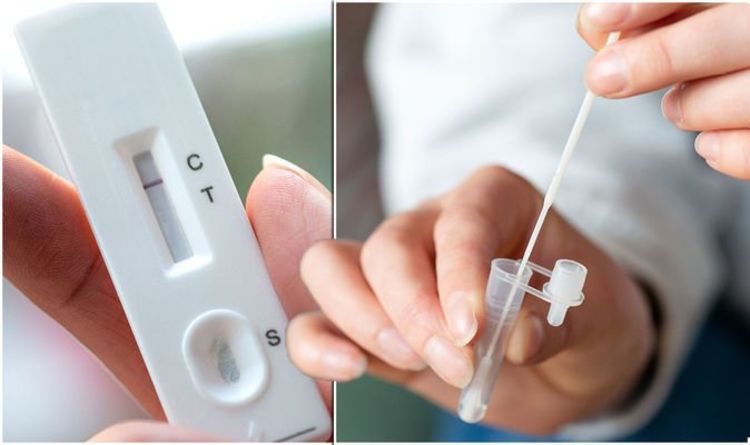BBC Breakfast: film students taking lateral flow tests
We use your sign-up to provide content in ways you’ve consented to and to improve our understanding of you. This may include adverts from us and 3rd parties based on our understanding. You can unsubscribe at any time. More info
Lateral flow tests (LFT) are in high demand across the UK as the Omicron variant sees daily case rates surge to over 218,000 as of January 4, 2022. However, even if you have access to the coronavirus home testing kits, it is important you read and follow instructions carefully.
Failure to complete LFTs as directed could lead to an inaccurate result.
In some cases, tests report a false negative. False-negative LFT are more common than false positives, with the home tests having a high accuracy rate.
According to a meta-analysis of studies by medical database the Cochrane Library, lateral flow tests are able to detect an average of 72 percent of symptomatic cases and 58 percent of asymptomatic cases.
However, not taking the tests correctly can hinder this accuracy.


Four key mistakes you should look out for
Not washing or sanitising your hands before taking the test
The NHS advises people to “wash your hands with soap or use a hand sanitiser” before beginning the test or removing it from its packaging.
After removing the test, and blowing one’s nose, people are advised to “wash your hands again”.
In the event you do not wash your hands, this could lead to the test becoming contaminated.
DON’T MISS
B12 deficiency symptoms: The sign on your foot that’s a ‘red flag’ [REPORT]
Statins side effects – why you shouldn’t be put off by this symptom [INSIGHT]
High cholesterol: The sign of high levels that disappears when sitting [REVEALED]
Not leaving the swab to sit for long enough
After taking the swab from your nose, throat or nose and throat, some tests require the swab to sit within the test tube for a specific amount of time.
Others simply require the swab to be moved in a circular motion around the tube a specified number of times.
Before taking the test, be sure to read the instructions and follow them accordingly.
Failure to leave the swab in the test tube for long enough could lead to an inaccurate result.

Reading results outside of the specified window
The majority of tests must be allowed to develop for 30 minutes, though some makes have a shorter window of around 15 minutes.
Reading results before the test has had enough time to develop could lead to a false negative.
Gov.uk states: “Wait 30 minutes before you read your result.
“Waiting the full 30-minute development time before you read your result is very important.
“A positive result can appear at any time after 20 minutes, however, you must wait for the full 30 minutes to record a negative result as the test line (T) may take this long to appear.”
Similarly, one doctor has warned people not to return to tests after the specified development window, as the test could become contaminated during this time.
London-based A&E doctor Nathan Hudson-Peacock shared a picture of a test with a barely noticeable positive line on Instagram.
He said: “If a faint line appears after the interpretation time window, then this does not count as a positive result and you do not need to book a PCR or self-isolate (unless, of course, you have symptoms in which case you must isolate and book a PCR regardless of what the LFT result is).”
Swabbing just your nose (unless directed to)
In some cases, tests require a swab from both the nose and throat, while other LFT devices require just a nose swab.
Following the instructions for your specific testing kit is the best way to ensure accuracy.
However, if you have cold symptoms and are producing a negative result, a cell biologist at University College London has claimed that the throat swab may improve the chances of picking up the Omicron virus.
Posting to Twitter, Professor Jennifer L. Rohn said: “Well, there it is.
“Today, with the ‘wrong’ (i.e. cold) symptoms and after a string of negative LFTs, I finally took Twitter advice and swabbed my throat as well as my nose (no mean feat with that diddly stick).
“If you think you might have COVID, consider adding the throat sample.”
Source: Read Full Article
